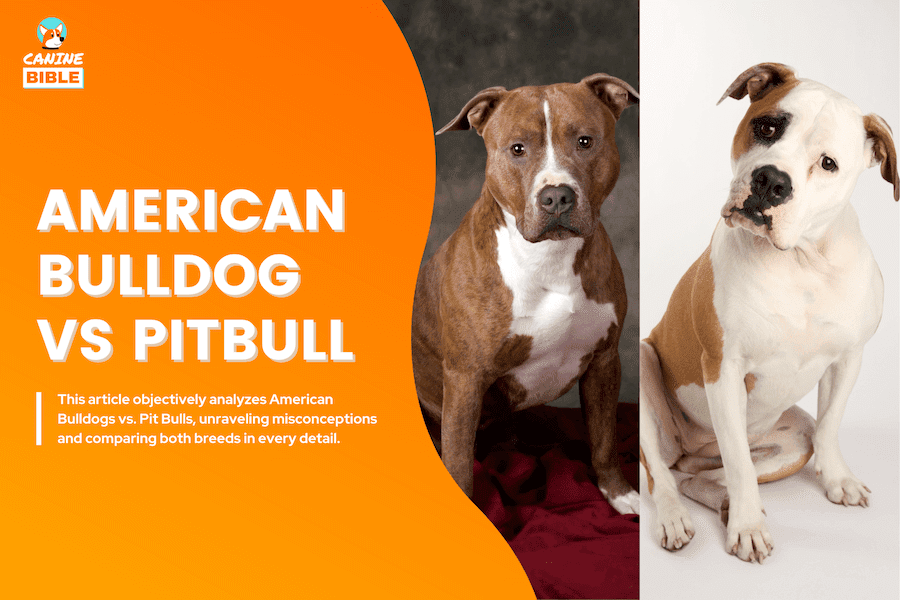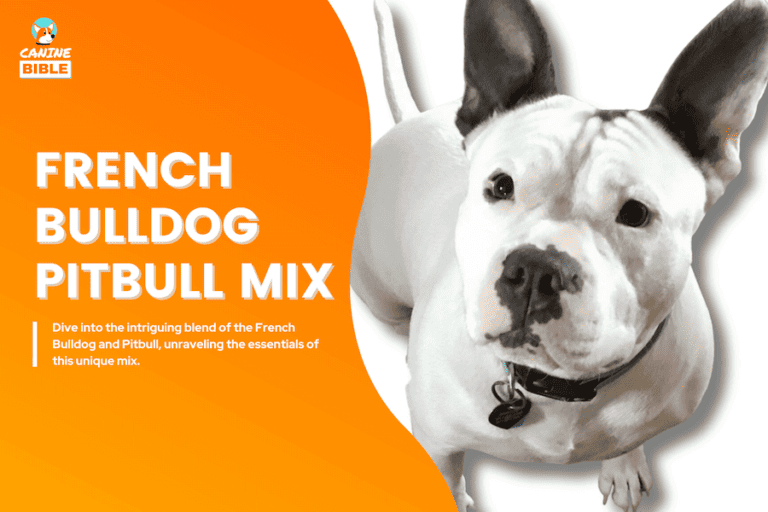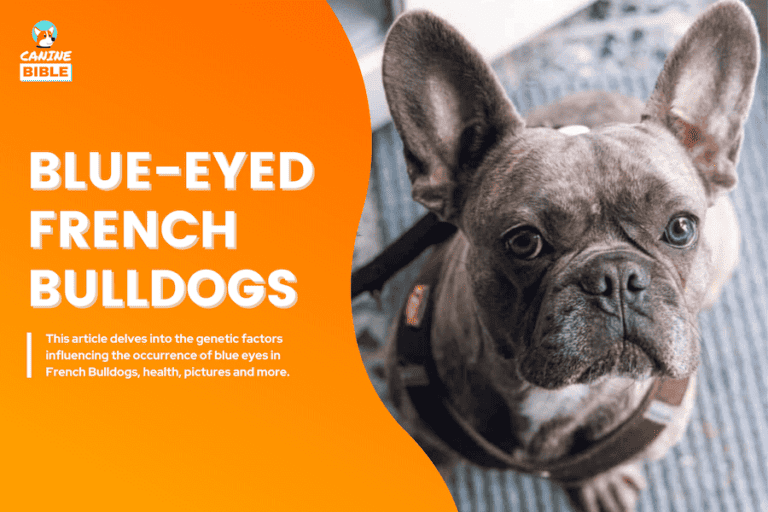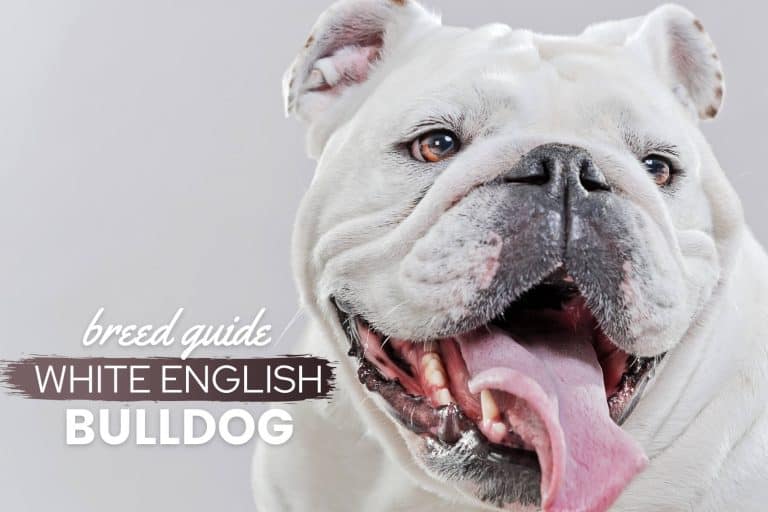American Bulldog Vs Pitbull: 10 The Differences — Is A Bulldog A Pitbull?

Canine Bible is reader-supported. We receive affiliate commissions via some of our links. This doesn’t affect rankings. Learn more.
This is the ultimate comparison guide between the American Bulldog vs Pitbull.
Are you wondering if the American Bulldog is the same as a Pitbull? It’s easy to mistake American Bulldogs for Pitbulls. While both share some similarities, they are entirely different breeds. However, most people don’t know how to tell them apart. But don’t worry, below we cover the main differences between the Pitbull and American Bulldog so you can finally tell them apart and help you decide which breed is a better fit for your family.
We teach you everything about the American Bulldog and Pit Bull, including a side-by-side comparison of their main characteristics, temperament, personality, history, size, strength, and more, so you can decide who would win your heart. Let’s dive right in!
American Bulldog vs Pitbull — [Infographic]
A visual snapshot of the main difference between American Bulldogs and Pitbulls.
American Bulldog vs Pitbull — Characteristics Comparison
Here is how American Bulldog’s characteristics compare to the Pit Bull’s.
| Characteristics | American Bulldog | American Pit Bull Terrier |
|---|---|---|
Affection Level | High | High |
Protectiveness | High | High |
Friendliness | High | High |
Kid-Friendly | High | High |
Pet-Friendly | Medium | Low |
Exercise Needs | High | High |
Playfulness | High | High |
Energy Level | Medium | High |
Trainability | Medium | High |
Intelligence | Medium | High |
Tendency to Bark | Medium | Medium |
Amount of Shedding | Low | Medium |
*Data sourced from TheSprucePets.com
Is An American Bulldog A Pitbull?
No, the American Bulldog is not a Pit Bull. They may seem the same, but they’re pretty different. While both breeds descend from the Old English Bulldog, the American Pit Bull Terrier is a cross of the Bulldog with the Terrier. They crossed these two breeds to create a more muscular and agile dog that could perform better in bull-bating and ratting. The Pit Bull is recognized as part of the Terrier family, while the American Bulldog is part of the Molosser dog family.
Note: The term “Pit Bull” is sometimes loosely used for American Staffordshire Terriers, Staffordshire Bull Terriers, American Pit Bull Terriers, and any dog that slightly resembles these breeds. In this article, when you hear the term “Pit Bull,” we are talking specifically about the American Pit Bull Terrier (APBT). And when we use the word “Bulldog,” we refer specifically to the American Bulldog (AB).
Are Pitbulls and Bulldogs Related?
The American Pitbull Terrier and the American Bulldog are descended from the Old English Bulldog, which English settlers brought to North America in the 1600s. The Old English Bulldog was a large, muscular dog used for bull-baiting, a popular blood sport. However, after bull-baiting was outlawed in 1835, the popularity of the Old English Bulldog began to decline. Some fanciers crossed it with other dogs, such as mastiffs and terriers, to preserve the breed. From these crosses, two new breeds emerged: the American Pitbull Terrier and the American Bulldog.
Though these two breeds are related through a common ancestor, they have been bred for different purposes and have very different physical characteristics.
Is An American Bulldog The Same As a Pitbull?
As stated above, an American bulldog is different from a Pitbull. However, both breeds have similarities in some areas.
These are some of the top similarities between American Bulldog and Pitbulls:
Difference Between American Bulldog & Pitbull
These are some of the top American Bulldog vs Pitbull differences.
Breed-specific legislation (BSL) is also different in certain states and cities. Most BSL forbids Pitbulls and other breeds from living in certain areas. It is important to research local laws and housing details before bringing home either dog breed, as bulldogs may or may not be included in BSL where you live or plan to travel. Please don’t do it after you commit to him because it’ll only end in tears.
American Bulldog vs Pitbull: Pictures
American Bulldog
Pitbull
Bulldog vs Pit Bull
Below is a research-based, side-by-side comparison analysis of the American Bulldog and Pit Bull Terrier.
We compare their history, breed characteristics, appearance, and other key differences and similarities.
- History & Origin
- Appearance (Chart)
- Temperament
- Characteristics
- Health
- Intelligence
- Cost
- Coat Color
- Training
- Exercise
- Grooming Needs
American Bulldog vs Pitbull: History
One way to tell the differences between a Pit Bull and Bulldog is by examining its history and origins.
American Bulldog
The American Bulldog (AB) can trace its roots to the English Bulldog. Working-class immigrants brought their old English Bulldogs to the United States in the 1800s to help with many tasks, including farm guardians, herding dogs, and hunting dogs. This breed’s original purpose was personal and property protection and to be a valuable tool for small farmers and ranchers in handling (catching) large animals such as cattle and hogs.
By the end of World War II, the breed was almost extinct. Still, some dedicated breeders, particularly in the southern states, decided to keep the breed alive as family companion dogs rather than farm dogs. The breed was not called a Bulldog because of its looks but because they were part of the English sport known as bull-baiting, which involved tethering a bull to a stake in the ground and encouraging dogs to try to bite the bull’s nose.
American Pit Bull Terrier
According to the United Kennel Club, The American Pit Bull Terrier (APBT) was created by crossbreeding Old English Bulldogs and terriers to produce a dog that combined the strength of the Bulldog with the gameness and agility of the Terrier.[1]
The Pit Bull Terrier also gained popularity in the British Isles for the sport of bull-baiting. Once bull-baiting was outlawed, the APBT was used for dogfighting and ratting, a betting sport where people bet to see whose Pit Bull could kill the most rats in the least amount of time.
Immigrants brought these bull-and-terrier crosses to the United States. As these cruel sports became less popular, the APBT talents did not go unnoticed. Pit Bull Terriers became farm dogs and family companions.
The “Pit” in Pit Bull comes from ratting, as the rats were placed into a pit so they could not escape.
History Similarities & Differences Shared By Bulldogs & Pitbulls
| Similarities | Differences |
|---|---|
| Both used in bull-baiting in England | The Pit Bull Terrier is a mixture of two breeds (bulldog and terriers) |
| Both used as farm dogs | The Pit Bull Terrier was specifically bred for ratting and dogfighting as these “sports” required more agility and speed on the part of the dog. |
| Both have English origins | The AKC does not recognize the Pit Bull while the American Bulldog is. |
American Bulldog vs Pitbull: Appearance
The most significant difference between an American Bulldog and a Pit Bull is their appearance.
The American Pit Bull Terrier is a medium-sized, solidly built, short-coated dog with smooth, well-defined musculature and an athletic-looking body. Males can grow between 18 to 21 inches tall at the shoulder and 35 to 60 pounds. Females can be 17 to 20 inches tall and 30 and 50 pounds.
In contrast, the American Bulldog is much larger. Males can grow between 22 to 25 inches and weigh 75 to 100 pounds. Females usually stand at 20-23 inches and weigh between 60-80 pounds.
American Pit Bull Terrier
American Bulldog
American Bulldogs have facial wrinkles, sometimes an underbite, a broader chest, and less-defined muscles than American Pit Bull Terrier. At first glance, it is easy to see why the American Bulldog might be mistaken for a Pit Bull. Still, you can easily recognize an American Bulldog for its trademark “bully” face and demeanor.
While both have a strong, sturdy, and muscular appearance, the American Bulldog has distinctive, prominent cheek muscles and a broader chest than the APBT. The American Bulldog has several unique features, including a large wide head, a broad muzzle, prominent cheek muscles, a large and wide nose, and powerful jaws. However, the Pit Bull has a leaner body, more defined muscles, and a broader skull than the American Bulldog.
American Bulldog vs Pitbull Appearance Comparison Chart
This chart compares and looks at the primary physical (size, color, etc.) traits and attributes of a Bulldog and Pit Bull.
| American Bulldog | American Pit Bull Terrier | |
|---|---|---|
Coat Color | Solid colors but usually white with black, brown, red, or brindle patches. | Any color, color pattern |
Height | 22-25 inches | 17-21 inches |
Weight | 75-100 pounds | 30-60 pounds |
Life Expectancy | 10-12 years | 12-14 years |
Gait | Smooth with speed, power, and agility | Effortless, smooth, powerful, and well coordinated |
Bite | Scissor bite or moderate under bite | Scissors bite |
Bite Force | 305 pounds | 235 pounds |
Head | Large and broad | Large and broad |
Feet | Well arched with strong nails and close together | Round, proportionate to the size of the dog, well arched, and tight |
Tail | Set low, thick at the base, tapering to a point | Set on as a natural extension of the topline, and tapers to a point |
Hindquarters | Wide and muscular with pretty deep flanks | Strong, muscular, and moderately broad. |
Coat | Soft or stiff | Glossy and smooth |
Neck | Muscular. Nearly as broad as the head | Muscular. Slight arch at the crest |
Ears | Forward flap or rose | High set and may be natural or cropped |
Eyes | Round or almond in shape, medium size, and wide set | Medium size, round and set well apart and low on the skull |
Nose | Long with wide nostrils | Large with wide, open nostrils |
Muzzle | Broad, thick and square | Broad and deep |
Source: American Bulldog EU [2]
American Bulldog vs Pitbull: Temperament
American Bulldogs and Pit Bulls have very similar temperaments and personalities.
American Bulldog
The temperament of the American Bulldog resembles that of an English bulldog. They are gentle and affectionate dogs that get along well with children and can be regarded as large lap dogs. They can be friendly and family-oriented dogs, especially if trained at a young age.
American Bulldogs are brave and strong-willed – they do well with owners who are unafraid to establish themselves as strong pack leaders. They are usually alert, have strong protective instincts, and can act reservedly toward strangers. American Bulldogs are loyal. They have a natural prey drive to be monitored around unknown, smaller animals such as cats or dogs.
American Pit Bull Terrier
According to Pamela Reid, Ph.D., vice president of the ASPCA’s Animal Behavior Center in New York, generally, Pit Bulls aren’t aggressive with people but are “less tolerant” of other dogs than many other breeds.
Despite this breed’s negative stereotypes and misconceptions, dog temperament studies show that pitties rank high among the most affectionate, tolerant, and least aggressive dogs.
In research conducted by the American Temperament Test Society, pit bulls passed at a rating of 86.4%, higher than popular breeds such as golden retrievers, corgis, and beagles. The American Bulldog came in above by a smidge with an 86.9% passing score.[3]
Conclusion
In general, the American Pit Bull Terrier is known for noted for its playful temperament and friendly nature. They are tenacious dogs that need early socialization and handling. American Pit Bull Terries are just as devoted and loyal to people as American Bulldogs, but Pit Bulls are more entertaining and happy dogs. They are excellent family dogs with proper training. However, it’s also important to highlight that both breeds can become very violent in the hands of irresponsible owners, who encourage aggression for fighting and protection.
| Similarities | Differences |
|---|---|
| High prey drive | Pitties can be more aggressive toward other animals due to they fighting lineage than American Bulldogs |
| They are both tenacious dogs | American Bulldogs might be a little be easier to socialize |
| They make great family dogs with proper training | Pit Bulls have higher energy levels and vivacity than Bulldogs |
| They are both loyal dogs | |
| Great temperament dogs |
Perhaps you are still not convinced Pit Bull can be loving companions. If that’s you, we encourage you to read a book called “I’m a Good Dog: Pit Bulls, America’s Most Beautiful (and Misunderstood) Pet” It is full of fascinating stories and the history of this particularly maligned breed.
Personality & Temperament Video
American Bulldog vs Pitbull: Health Problems
Health issues that American Bulldogs and American Pit Bull Terriers share
Like other breeds, the American Bulldog and the APBT can potentially develop genetic health problems. You can avoid these risks by doing an at-home dog DNA health test to identify potential medical complications.
Health Issues Specific to American Bulldogs
According to PetMD, American Bulldogs are prone to the following health issues:
Also, due to their facial wrinkles, American Bulldogs may be prone to skin problems from chafing, heat, and moisture. You can use a Squishface Wrinkle Paste to clean and protect your dog’s wrinkles, tear stains, and tail pockets.[4]
Health issues specific to American Pit Bull Terriers
The American Pit Bull Terrier can develop several health problems, including:
Identify genetic risks related to drug sensitivities, vision, weight, mobility, and more.
American Bulldog vs Pitbull: Intelligence
The American Pit Bull Terrier Intelligence Index (ABI) has average to above-average intelligence.
According to Stanley Coren Intelligence Test, dog breeds in the pit bull category (i.e., APBT), namely the Staffordshire Bull Terrier and American Staffordshire Terrier, have average to above-average intelligence. This means these dogs can understand a new command with 15 to 25 repetitions and obey a known command (on the first attempt) 70% of the time.[5]
Similarly, American Bulldogs are extremely intelligent dogs. This high intelligence and strong working drive mean American Bulldogs are trainable dogs.
While there are no official records of intelligence tests for American Bulldogs, it’s safe to say that both dogs are equally intelligent. These dogs were bred for jobs (i.e., herding livestock) requiring decision-making, intelligence, and concentration. That’s something the average dog is not built for.
American Bulldog vs Pitbull: Cost
Prices can vary! But here is what you can expect to pay for a Bulldog or Pit Bull.
On average, American Bulldogs cost from $1,700 to $8,000 or even more for an American Bulldog, a superior pedigree. The average price for all American Bulldogs sold is $800. American Pit Bull Terriers are slightly more expensive, with an average price of $1100. But prices for American Pit Bull Terriers fluctuate between $3,700 to $10,000.
APBT or American Bulldogs may be available at your local shelter if you want to adopt.
*Data sourced from the sale of American Bulldogs & American Pit Bull Terrier puppies across the United States on NextDayPets.com
American Bulldog vs Pitbull: Coat Color
According to the American Kennel Club breed standard, American Bulldogs come in several colors. The standard color of the American Bulldog is white with patches of brindle, red, tan, brown, or black, but there are quite a few more color variations (non-standard colors) such as white and black, white and brindle, white and brown, and white and tan.[6]
American Pit Bull Terrier, on the other hand, comes in various shades, ranging from a creamy blonde to an almost reddish hue.
American Bulldog vs Pitbull: Training
Early socialization and puppy training classes are suggested for both of these breeds. Both the American Bulldog and Pit Bull are intelligent but stubborn. They like to please and are agreeable. However, training can be difficult for someone who is not a pack leader.
During training, you must be a natural leader, consistent and kind to channel these dogs’ energy and establish and retain proper boundaries. The United Kennel Club says that because some “APBTs exhibit some level of dog aggression and because of its powerful physique, the APBT requires an owner who will carefully socialize and obedience train the dog.” [7]
Without structured activity, like regular training and play to exercise, American Bulldogs and American Pit Bull Terriers quickly become bored, leading to destructive behaviors. Whether raising or training an American Bulldog, teaching them to be extraordinarily calm and obedient is essential. K9 Training Institute‘s workshop is an excellent training resource if you need to help to housebreak your dog. They will teach you the methods service dog handlers use with their pups.
You can also read the bible for any American Bulldog owner by renowned Canine author Matthew Masterson. It will help you care for, train, and build a successful partnership with your pup. If you own a Pit Bull Terrier, this book is the definitive resource for seasoned Pit Bull owners and novices.
American Bulldog vs Pitbull: Exercise Needs
American Bulldog
The American Bulldog is one of the most energetic and athletic of all Molossers. This breed should perform vigorous daily physical activity for 45 minutes to an hour. American Bulldogs can perform various activities, from jogs, hikes, and tug-a-war games to training exercises. However, be mindful that this breed is prone to develop bone and joint damage. Aim for non-impact exercises to decrease these health risks.
American Pit Bull Terrier
American Bulldogs have very high exercise requirements. An under-exercised American Bulldog may lead to behavior problems related to pent-up energy, such as destructiveness, excessive barking, hyperactivity, over-excitability, nervousness, and aggression. According to Cesar Milan, pit bulls are just as energetic as the American Bulldog and should get a minimum of 30 to 45 minutes of vigorous exercise daily.
Conclusion
Developing both dogs’ athletic abilities will help them stay fit and happy. You can use a toy like Chuckit Sport Launcher to give them a fun workout and try Nina Ottosson Dog Smart Puzzle for a mentally stimulating exercise.
Both breeds, however, have powerful bites that can destroy a toy in seconds. We recommend getting tough toys specially made for heavy chewers like Pit Bulls and American Bulldogs. They are designed not to break and provide the most optimal stimulating experience.
American Bulldog vs Pitbull: Grooming Needs
Luckily, grooming your American Bulldog or Pit Bull Terrier is pretty straightforward. They have short hair and are seasonal shedder. To groom either breed, try to brush their coat at least once a week with a soft to medium bristle brush to help distribute their natural oils and remove loose hair and debris. Occasional, bathing with a shampoo made for dogs will help them stay clean and shiny when they become dirty.
Trim their every few weeks, and ears should be cleaned once a month or as needed, especially in Pit Bull Terriers since they have perky ears that are susceptible to infection.
American Bulldog vs Pitbull — Video Comparison
American Bulldog Video
Watch this video and learn about the American Bulldog to understand how it compares and differs from Pitbulls.
American Pit Bull Terrier Video
Watch this video and learn about the American Pit Bull to better understand how it compares and differs from Bulldogs.
American Bulldog Vs Pitbull — Frequently Asked Questions
Here are the most commonly asked questions about American Bulldog Vs Pitbull.
American Bulldog Vs Pitbull — Conclusion
We hope we could clear up most of the questions regarding the American Bulldog vs. Pit Bull debate. You can’t go wrong with either option if you consider getting either pup. The American Bulldog and the Pit Bull Terrier are great dog choices. They are both sociable and love nothing more please their masters.
The main difference between the American Bulldog and the American Pit Bull Terrier is that the latter is slightly smaller but more athletic and energetic. The American Bulldog is more chill in temperament but equally fun.
Both these breeds are a fantastic family addition. Regardless of your choice, you can come home with a dog everybody loves and adores!
Like It? Subscribe & Share!
Canine Bible authorship represents the unified voice of our entire editorial team and our in-house veterinarians rather than a single author. Each article, blog post, and review published under the Canine Bible name undergoes a rigorous review process, involving all team members to guarantee accuracy and up-to-date in accordance with the latest veterinarian research. This collaborative effort is an integral part of our editorial process and aligns with our four pillars of content creation. This approach ensures our content is backed by expert knowledge and factual information, offering our readers reliable, actionable, and trustworthy content.








